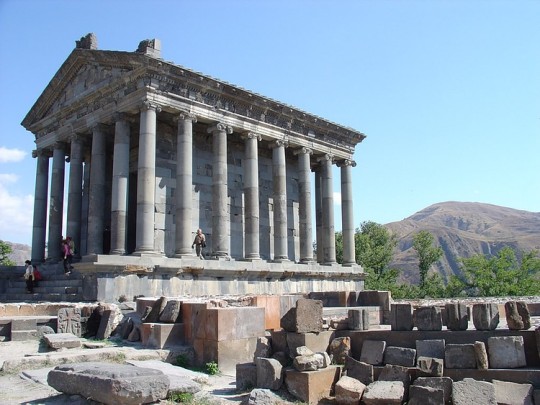#AreniCave
Explore tagged Tumblr posts
Photo

Ancient Armenia
Ancient Armenia, located in the south Caucasus area of Eurasia, was settled in the Neolithic era but its first recorded state proper was the kingdom of Urartu from the 9th century BCE. Incorporated into the Persian Empire of Cyrus the Great in the 6th century BCE, the Orontid dynasty ruled as Persian satraps, a function they performed for their next overlords the Macedonians and Seleucid Empire into the 3rd century BCE. Under the Artaxiad and Arsacid dynasties the country flourished but was often caught between the ambitions of Parthia and Rome, and then the Sasanian and Byzantine Empires. The boundaries of the state varied considerably over the centuries but such common factors as religion and language were united by long-lasting dynastic clans, which gave Armenia its own unique identity throughout antiquity.
Hayasa-Azzi (1500-1200 BCE)
The first identifiable culture in the region is the Hayasa-Azzi, an indigenous tribal confederation which flourished on the fertile plateau of ancient Armenia around Mount Ararat and parts of modern-day eastern Turkey between c. 1500 and c. 1200 BCE. The Hayasa-Azzi are the eponym of the Hay people, the term Armenians use to describe themselves and their state, Hayastan. Over time, the Hayasa-Azzi mixed with other ethnic groups and local tribes such as the Hurrians, Arme-Shupria, and Nairi, probably motivated by the need for defence against more aggressive and powerful neighbours like the Hittites and the Assyrians. They were probably infiltrated by the Thraco-Phrygians following the collapse of the Hittite Empire c. 1200 BCE. Eventually, these various peoples and kingdoms would be fused into the region's first recognisable and recorded state, the kingdom of Urartu from the 9th century BCE.
Continue reading...
91 notes
·
View notes
Text
ARENI CAVE VI. MP4:
At the Site Entrance [Mediterranean Pottery] Late Chalcolithic | Early Bronze Age Archaeological Site in Armenia https://en.wikipedia.org/wiki/Areni-1_cave
Areni 1 Cave, Armenia | A1CA
Web : https://www.arenicave.am/en
FB : https://www.facebook.com/AreniCave
YT : https://www.youtube.com/@areni1cavescientific-resea757
A1CA | Michael Svetbird ph©msp | 12|23 MP4 [VI. Vid]
#armenia#հայաստան#areni#areni cave#areni 1 cave#cave#Արենիի քարանձավ#archaeological site#chalcolithic#bronze age#prehistoric#ancient#antiquity#archaeology#ancient history#ancient world#ancient cultures#excavations#heritage#worship#cult#winery#burial#pottery#museology#travel#museum photography#archaeology photography#travel photography#michaelsvetbird
8 notes
·
View notes
Photo

Ancient Armenia
Ancient Armenia, located in the south Caucasus area of Eurasia, was settled in the Neolithic era but its first recorded state proper was the kingdom of Urartu from the 9th century BCE. Incorporated into the Persian Empire of Cyrus the Great in the 6th century BCE, the Orontid dynasty ruled as Persian satraps, a function they performed for their next overlords the Macedonians and Seleucid Empire into the 3rd century BCE. Under the Artaxiad and Arsacid dynasties the country flourished but was often caught between the ambitions of Parthia and Rome, and then the Sasanian and Byzantine Empires. The boundaries of the state varied considerably over the centuries but such common factors as religion and language were united by long-lasting dynastic clans, which gave Armenia its own unique identity throughout antiquity.
Hayasa-Azzi (1500-1200 BCE)
The first identifiable culture in the region is the Hayasa-Azzi, an indigenous tribal confederation which flourished on the fertile plateau of ancient Armenia around Mount Ararat and parts of modern-day eastern Turkey between c. 1500 and c. 1200 BCE. The Hayasa-Azzi are the eponym of the Hay people, the term Armenians use to describe themselves and their state, Hayastan. Over time, the Hayasa-Azzi mixed with other ethnic groups and local tribes such as the Hurrians, Arme-Shupria, and Nairi, probably motivated by the need for defence against more aggressive and powerful neighbours like the Hittites and the Assyrians. They were probably infiltrated by the Thraco-Phrygians following the collapse of the Hittite Empire c. 1200 BCE. Eventually, these various peoples and kingdoms would be fused into the region's first recognisable and recorded state, the kingdom of Urartu from the 9th century BCE.
Continue reading...
105 notes
·
View notes
Text




ARENI CAVE: Late Chalcolithic | Early Bronze Age Archaeological Site in Armenia https://en.wikipedia.org/wiki/Areni-1_cave
[ Pic 4 - Bronze [and 1 stone] Battle-Axes, 15-14 BC, History Museum of Armenia: https://historymuseum.am/en ].
Areni 1 Cave, Armenia | A1CA
Web : https://www.arenicave.am/en
FB : https://www.facebook.com/AreniCave
YT : https://www.youtube.com/@areni1cavescientific-resea757
A1CA | Michael Svetbird phs©msp | 12|23 6300X4200 600 [I.-V.] [Non-commercial fair use | No AI | Author rights apply | Sorry for the watermarks]
Pls see mp4 short vid below
#armenia#հայաստան#areni#areni cave#areni 1 cave#cave#Արենիի քարանձավ#archaeological site#chalcolithic#bronze age#prehistoric#ancient#antiquity#archaeology#ancient history#ancient world#ancient cultures#excavations#heritage#worship#cult#winery#burial#pottery#museology#travel#museum photography#archaeology photography#travel photography#michaelsvetbird
2 notes
·
View notes